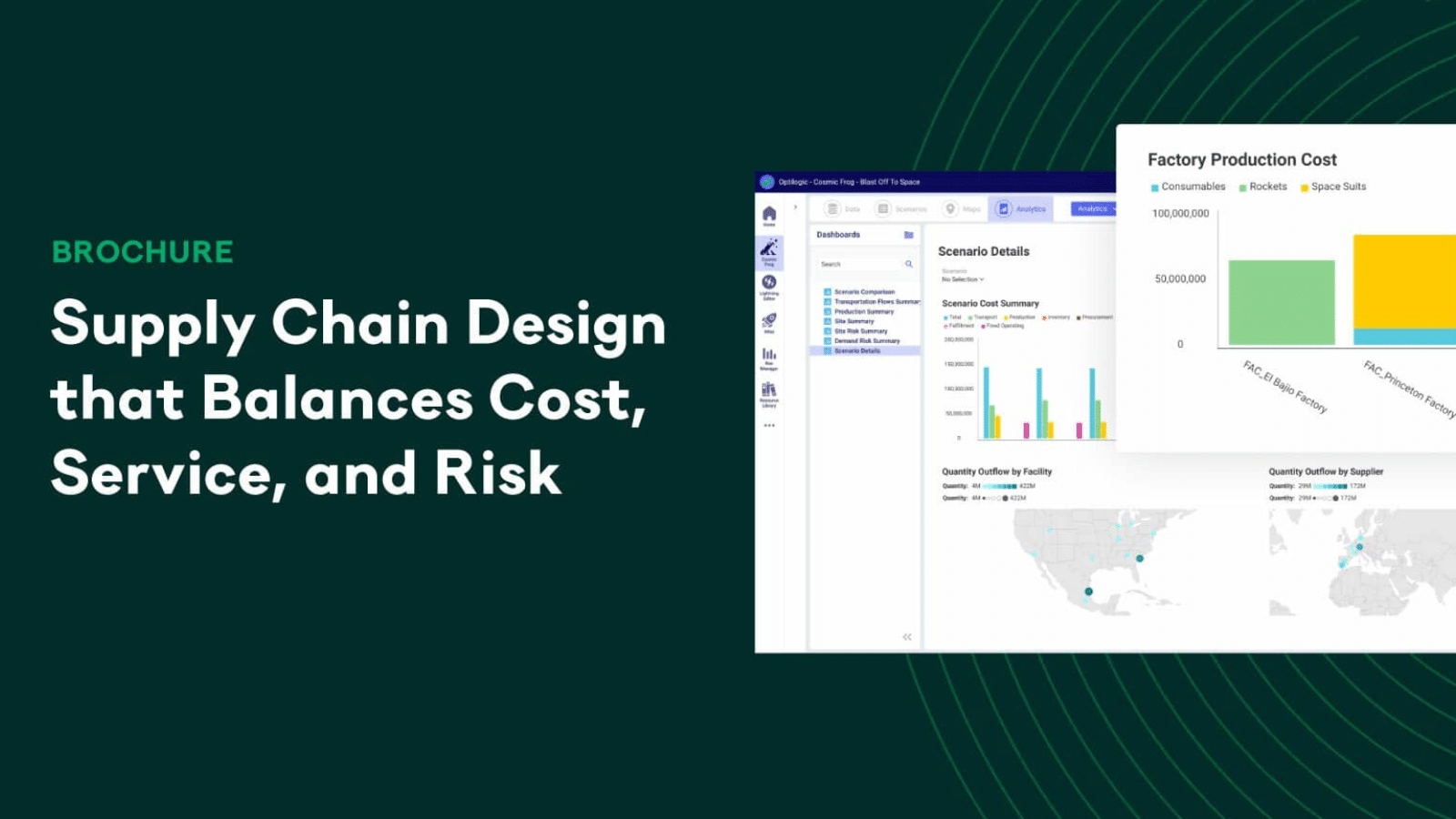
Post-COVID uncertainty demands a new level of supply chain design technology. Cosmic Frog is the only supply chain design solution that offers optimization, simulation, and risk analysis across an end-to-end supply chain in a single platform, equipping businesses to make more informed decisions beyond just cost.
Published by
Published on
February 28, 2022





If you don’t intelligently design your supply chain, it will design itself, and that could be catastrophic for your business.Cosmic Frog is the only supply chain design solution that offers optimization, simulation, and risk analysis across an end-to-end supply chain in a single platform, equipping businesses to make more informed decisions beyond just cost.Create your free Cosmic Frog account today.JTNDaDQlM0VEb3dubG9hZCUyMHRoZSUyMEJyb2NodXJlJTNDJTJGaDQlM0UlMEElM0NkaXYlMjBjbGFzcyUzRCUyMmhzLWN0YS1lbWJlZCUyMGhzLWN0YS1zaW1wbGUtcGxhY2Vob2xkZXIlMjBocy1jdGEtZW1iZWQtMTM2NDgyMzAzNTM1JTIyJTBBJTIwJTIwc3R5bGUlM0QlMjJtYXgtd2lkdGglM0ExMDAlMjUlM0IlMjBtYXgtaGVpZ2h0JTNBMTAwJTI1JTNCJTIwd2lkdGglM0EyMTBweCUzQmhlaWdodCUzQTQyLjM5MDYyNXB4JTIyJTIwZGF0YS1odWJzcG90LXdyYXBwZXItY3RhLWlkJTNEJTIyMTM2NDgyMzAzNTM1JTIyJTNFJTBBJTIwJTIwJTNDYSUyMGhyZWYlM0QlMjJodHRwcyUzQSUyRiUyRmN0YS1zZXJ2aWNlLWNtczIuaHVic3BvdC5jb20lMkZ3ZWItaW50ZXJhY3RpdmVzJTJGcHVibGljJTJGdjElMkZ0cmFjayUyRnJlZGlyZWN0JTNGZW5jcnlwdGVkUGF5bG9hZCUzREFWeGlnTEl5R0pPZzF5UWclMjUyRkdBZm9ianZ4a0NGUjY1R1FFbFptYyUyNTJCOURXRHN5dERsayUyNTJCSFFaQ0hJNFZTVkdmUkZudHl3QzRkcjJORFZkQXYxVHVVUHdKJTI1MkZ4SUZWJTI1MkZxdkhlOXl0aUolMjUyRlpQclBha1h1dVN5WUE5UnFrcjFDUCUyNTJGc2pvRmdldFhFMVAzZklwMmoxMlo3NmNxeXA2TXM2OUFvYm5HRmtPNURjQ3RnWWZ6ZHRRNGtaRUdBcyUyNTJGRUFXeXJBdkxHMXdxb1o1MCUyNTJCaXA3NVliNCUyNTJCa1YwWVM3Z1RtOG1qUjFvR3g4eTd5WEhpS3FIYyUyNTJGcENUdUF5b2dHS1Iwd2Z0N3lFJTI1M0QlMjZ3ZWJJbnRlcmFjdGl2ZUNvbnRlbnRJZCUzRDEzNjQ4MjMwMzUzNSUyNnBvcnRhbElkJTNENzEyNTU5MiUyMiUyMHRhcmdldCUzRCUyMl9ibGFuayUyMiUyMHJlbCUzRCUyMm5vb3BlbmVyJTIyJTIwY3Jvc3NvcmlnaW4lM0QlMjJhbm9ueW1vdXMlMjIlM0UlMEElMjAlMjAlMjAlMjAlM0NpbWclMjBhbHQlM0QlMjJHZXQlMjB0aGUlMjBCcm9jaHVyZSUyMiUyMGxvYWRpbmclM0QlMjJsYXp5JTIyJTIwc3JjJTNEJTIyaHR0cHMlM0ElMkYlMkZuby1jYWNoZS5odWJzcG90LmNvbSUyRmN0YSUyRmRlZmF1bHQlMkY3MTI1NTkyJTJGaW50ZXJhY3RpdmUtMTM2NDgyMzAzNTM1LnBuZyUyMiUyMHN0eWxlJTNEJTIyaGVpZ2h0JTNBJTIwMTAwJTI1JTNCJTIwd2lkdGglM0ElMjAxMDAlMjUlM0IlMjBvYmplY3QtZml0JTNBJTIwZmlsbCUyMiUwQSUyMCUyMCUyMCUyMCUyMCUyMG9uZXJyb3IlM0QlMjJ0aGlzLnN0eWxlLmRpc3BsYXklM0QlMjdub25lJTI3JTIyJTIwJTJGJTNFJTBBJTIwJTIwJTNDJTJGYSUzRSUwQSUzQyUyRmRpdiUzRSUwQSUwQQ==
If you don’t intelligently design your supply chain, it will design itself, and that could be catastrophic for your business.Cosmic Frog is the only supply chain design solution that offers optimization, simulation, and risk analysis across an end-to-end supply chain in a single platform, equipping businesses to make more informed decisions beyond just cost.Create your free Cosmic Frog account today.JTNDaDQlM0VEb3dubG9hZCUyMHRoZSUyMEJyb2NodXJlJTNDJTJGaDQlM0UlMEElM0NkaXYlMjBjbGFzcyUzRCUyMmhzLWN0YS1lbWJlZCUyMGhzLWN0YS1zaW1wbGUtcGxhY2Vob2xkZXIlMjBocy1jdGEtZW1iZWQtMTM2NDgyMzAzNTM1JTIyJTBBJTIwJTIwc3R5bGUlM0QlMjJtYXgtd2lkdGglM0ExMDAlMjUlM0IlMjBtYXgtaGVpZ2h0JTNBMTAwJTI1JTNCJTIwd2lkdGglM0EyMTBweCUzQmhlaWdodCUzQTQyLjM5MDYyNXB4JTIyJTIwZGF0YS1odWJzcG90LXdyYXBwZXItY3RhLWlkJTNEJTIyMTM2NDgyMzAzNTM1JTIyJTNFJTBBJTIwJTIwJTNDYSUyMGhyZWYlM0QlMjJodHRwcyUzQSUyRiUyRmN0YS1zZXJ2aWNlLWNtczIuaHVic3BvdC5jb20lMkZ3ZWItaW50ZXJhY3RpdmVzJTJGcHVibGljJTJGdjElMkZ0cmFjayUyRnJlZGlyZWN0JTNGZW5jcnlwdGVkUGF5bG9hZCUzREFWeGlnTEl5R0pPZzF5UWclMjUyRkdBZm9ianZ4a0NGUjY1R1FFbFptYyUyNTJCOURXRHN5dERsayUyNTJCSFFaQ0hJNFZTVkdmUkZudHl3QzRkcjJORFZkQXYxVHVVUHdKJTI1MkZ4SUZWJTI1MkZxdkhlOXl0aUolMjUyRlpQclBha1h1dVN5WUE5UnFrcjFDUCUyNTJGc2pvRmdldFhFMVAzZklwMmoxMlo3NmNxeXA2TXM2OUFvYm5HRmtPNURjQ3RnWWZ6ZHRRNGtaRUdBcyUyNTJGRUFXeXJBdkxHMXdxb1o1MCUyNTJCaXA3NVliNCUyNTJCa1YwWVM3Z1RtOG1qUjFvR3g4eTd5WEhpS3FIYyUyNTJGcENUdUF5b2dHS1Iwd2Z0N3lFJTI1M0QlMjZ3ZWJJbnRlcmFjdGl2ZUNvbnRlbnRJZCUzRDEzNjQ4MjMwMzUzNSUyNnBvcnRhbElkJTNENzEyNTU5MiUyMiUyMHRhcmdldCUzRCUyMl9ibGFuayUyMiUyMHJlbCUzRCUyMm5vb3BlbmVyJTIyJTIwY3Jvc3NvcmlnaW4lM0QlMjJhbm9ueW1vdXMlMjIlM0UlMEElMjAlMjAlMjAlMjAlM0NpbWclMjBhbHQlM0QlMjJHZXQlMjB0aGUlMjBCcm9jaHVyZSUyMiUyMGxvYWRpbmclM0QlMjJsYXp5JTIyJTIwc3JjJTNEJTIyaHR0cHMlM0ElMkYlMkZuby1jYWNoZS5odWJzcG90LmNvbSUyRmN0YSUyRmRlZmF1bHQlMkY3MTI1NTkyJTJGaW50ZXJhY3RpdmUtMTM2NDgyMzAzNTM1LnBuZyUyMiUyMHN0eWxlJTNEJTIyaGVpZ2h0JTNBJTIwMTAwJTI1JTNCJTIwd2lkdGglM0ElMjAxMDAlMjUlM0IlMjBvYmplY3QtZml0JTNBJTIwZmlsbCUyMiUwQSUyMCUyMCUyMCUyMCUyMCUyMG9uZXJyb3IlM0QlMjJ0aGlzLnN0eWxlLmRpc3BsYXklM0QlMjdub25lJTI3JTIyJTIwJTJGJTNFJTBBJTIwJTIwJTNDJTJGYSUzRSUwQSUzQyUyRmRpdiUzRSUwQSUwQQ==
Fill out the form to unlock the full content

.png)

.png)